You’ll find part I of my Italy trip journal here.
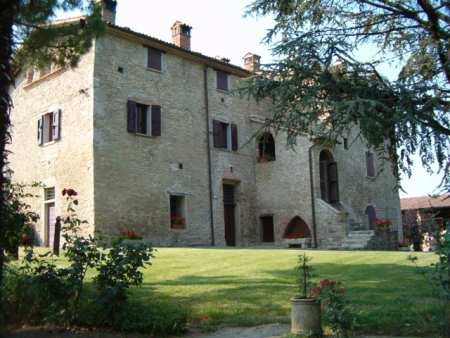
Ancient stones beckon.
After a much shorter thrill ride into the Parma countryside, we arrived safely at their agriturismo. For those unfamiliar with the term, the Italian government encourages farmers to open their homes to tourists as hotels while continuing their farming operations (they must keep working the land to retain their permit). The farmers get a tax break, and travelers experience life in the country. Some agriturismi are nothing more than converted barns, but this one has six small suites. As it is November, I am the only traveler, so I have the whole guest area to myself.
The main house is best described as a mansion: a three-story stone building awash with brightly painted blue doors and vibrant art. Weathered window frames and worn stone floors testify to the many who have passed through. Colorful pots line the stairways as they wind to the upper levels. My temporary home was built over 150 years ago; though damaged during the war, it has been extensively remodeled and retains its old-world charm. Looking down the hillside toward Quattro Castella, the vista opens to rolling meadows flecked with grey stones and ancient vines.
I barely had time to collapse on the bed before I was summoned to the kitchen to meet the grand matriarch of the family. She must be in her late 80s but spends most afternoons in a large commercial kitchen, working at huge wooden counters to prepare daily meals. Everything is done by hand. I spent hours watching Nonna make orecchiette while her daughter translated back and forth to her. Sitting in that old kitchen with afternoon sun streaming through the windows, warm air puffing from the ovens, and two generations cooking together made me forget all the troubles of the world.
Soon I was up to my wrists in pasta dough, trying to duplicate the little “ears.” I managed a single, rather misshapen one in the time it took Nonna to make five. She assured me that at my current rate, I’d be as good as she is by the time I turn 90.
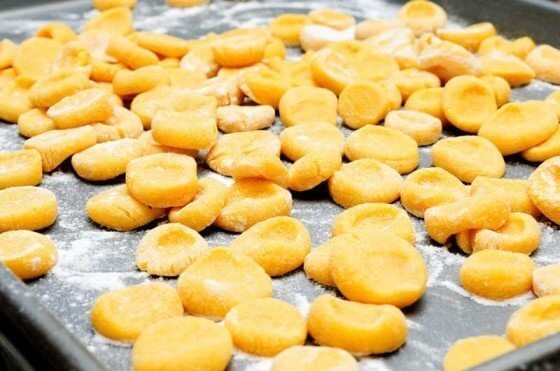
The home feels like a museum. One of the daughters, Allecra, gave me a tour and casually handed me religious carvings hundreds of years old. We wandered into the main dining area, anchored by a huge stone fireplace that seemed to heat most of the downstairs. A sturdy old wooden table stretched across the room, scarred by a century of gatherings. By my count, it could hold 22 people. The walls were lined with memorabilia: dusty wine bottles, old corkscrews, medals, and citations. In a butler’s pantry, eighty-pound wheels of Reggiano were stacked high, stamped with the family crest and government seal. I am engulfed in gustatory heaven, and am being called to dinner!
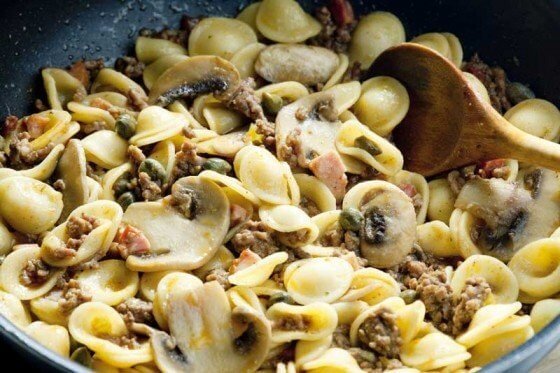
That night, the whole family gathered at the table. I don’t think this is an every-night tradition; perhaps it was for my benefit. Introductions were a blur, but I managed to remember the most important names. These generous people put food away like no one I’ve ever seen. Overflowing platters came steaming from the kitchen: tigelle e gnocco fritto, pasta, pork, wild boar, chicken. The air smelled of fennel and rosemary smoke. And the wine—good God, the wine—it never stopped flowing. We began with Lambrusco and continued through bottle after bottle.
Toasts were constant: to me, to their son in Sonoma Valley, to pregnancies, to a new marriage, to life itself. Each toast meant drinking, and each glass was immediately refilled. Still hungover from the day before, I began to feel like I’d stepped into a Fellini movie. My mind jumbled Spanish, Italian, Greek, and French into single sentences. They looked at me as if I were an addled American until I gave up trying to talk and just sat grinning stupidly. We finished with balsamic vinegar drizzled over aged prosciutto. At one point, I seriously considered crawling under the table for a nap.
The rest of the evening blurred. The family argued energetically about where I should go; clearly, I had no say in the matter. Finally, the plan was set: one day at the agriturismo, then south to Montalcino for wine, Montepulciano for lunch with family, and Cortona to see a Fra Angelico. After that, Ferrara, Maranello, and the Duomo of Modena.
The next morning, I was awakened with breakfast in bed (served with perhaps too much attention by one of the sons, whom I was beginning to wonder about). Food? I hadn’t even dried out enough to be hungover. But the eggs baked with a pearly grating of Parmigiana and home-cured bacon curled my toes as I lay on the four-poster bed looking at the early morning sun painting the fields in dappled beige.
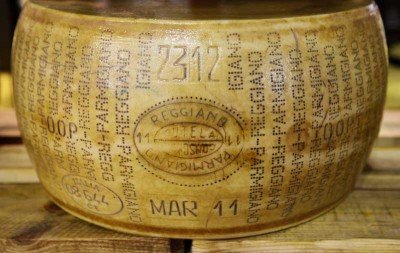
I can now make a fairly accurate guess as to what time of year a block of Reggiano was produced, simply by tasting and examining its texture. Maybe not every time, but I’m getting good at it. Some are much sweeter or more buttery than others, and some are slightly sharp. I think this is a fascinating example of terroir, but I’m told that the Italians are trying to standardize it, so the flavors will be consistent, which seems sad. The city of Parma is known for Parmigiano Reggiano and Prosciutto di Parma. My kidnappers have made cheese for centuries, and we spent the day at the beautiful family facility, which uses a mixture of modern and centuries-old techniques. They have taken me through the process of making Reggiano from start to finish. Massive copper vats steamed with hot milk. The air was dense and heady. I helped move heavy blocks of cheese from one bath to another as they were processed, scrubbed, and brined. The sons swung aging wheels from rack to rack with ease and laughed when I suggested rolling them like tires. A knock on the rind sang an aria to them, telling the tale of age. I wanted nothing more than to crawl into one of the troughs and soak out the previous night’s wine. Later, we tasted Parmigiano-Reggiano of various ages, paired with wines and, of course, very old balsamic vinegar—heaven for someone who has been known to sip it straight from the bottle. The evening ended more simply: fall greens, prosciutto, cheese, and leftovers from the feast.
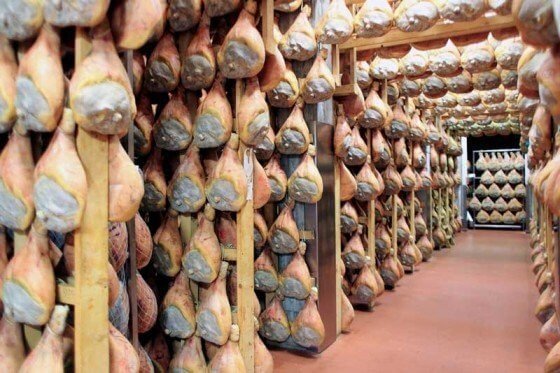
Most of these small towns are fairly close together, at least the way Italians drive. My hosts seem to know everyone wherever they go, so I am constantly introduced to more people – and I’m still trying to remember the names of this family! Now I just point, smile, and try to keep up. I find my Italian is getting better, and I’m now able to understand everyone fairly well. Just don’t ask me to speak it back, as they all laugh, mouths hidden behind clasped hands.
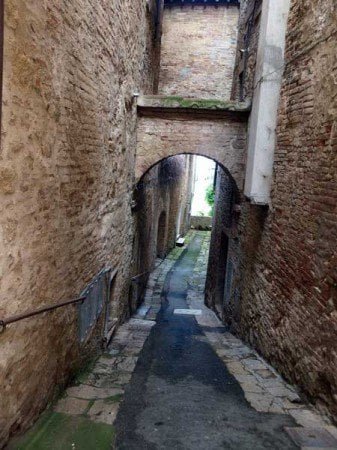
Seriously, this is what the streets are like
Montepulciano, a medieval and Renaissance hill town, is encircled by walls and fortifications.
Quiet in November, it was a pleasure to explore its tiny alleys and Renaissance churches. A cousin ran a small restaurant on the square; hearing that I liked to cook, he gave me a kitchen tour and then served a meal that warmed us from the inside out. Vino Nobile di Montepulciano flowed with every course. A truffle the size of a child’s fist appeared and was grated onto everything. It was glorious—but I found myself fantasizing about French fries.
We walked off lunch by climbing the Corso to the Piazza Grande. Festivals are held here in summer, but today the streets were still and cool. Later, we visited an enoteca inside a 14th-century fortress, where, naturally, more wine was consumed.
Our explorations were followed by a visit to a great enoteca inside a 14th-century Fortezza at the edge of town, where more wine was consumed, fortunately, followed by more walking. This area reminds me of California wine country: very hilly, and the locals of Poliziani are obsessed with wine and food. It seems everyone has bottles of vino nobile under their stairs.
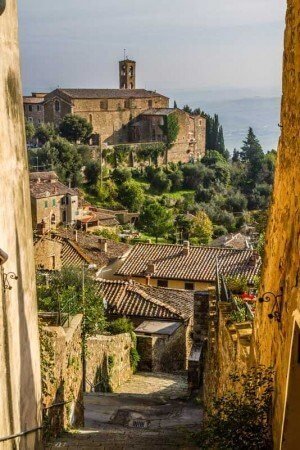
Later, we stopped at the abbey of Sant’Antimo, where Gregorian chant filled the Romanesque nave and alabaster carvings glowed with afternoon light. I thought again of centuries of love, loss, and prayer etched into stone. Light streamed in through the windows, setting a carving of Daniel in the Lion’s Den aglow. It was hauntingly beautiful, and I had to wander off for a few minutes to collect myself, once again running my hands across the travertine, thinking of all the people who had done the same in the last 889 years; the love, the happiness, the sorrow… history under my fingertips. I wished my feet were bare.
The next stop, Montalcino, is a walled town, high on a hill. As you approach on a dusty, twisting road through the vineyards and a large fortress dominates the southern end. Spires of medieval towers sprout from the middle. Stone buildings hanging off the cliff make it look even more imposing. This is a no-cars city, so you park in a lot outside the walls – a fantastic idea that plunges you back in time. Entering the town feels less intimidating and even older than Montepulciano. We ignored the touristy La Fortezza and instead wandered deeper into the city, following twisting stairs and alleyways until we arrived at the house of yet more cousins.
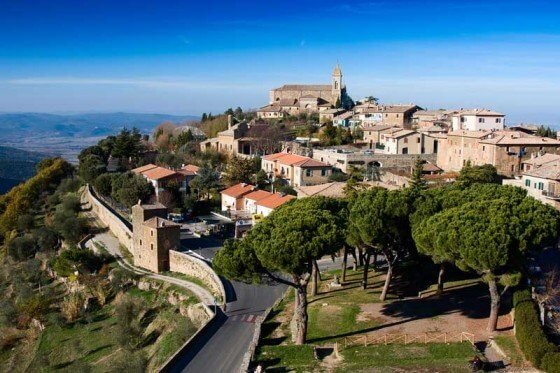
Soon we were off again, this time to Montalcino, home of Brunello. The approach—winding roads, vineyards, a looming fortress—was breathtaking. No cars are allowed inside, so parking outside the walls made the entry feel like stepping back in time. The town felt even older and sterner than Montepulciano. Cousins awaited us there too: more food, more wine, more laughter. Sitting in a tiny stone house, I felt that heady mix of history, hospitality, and wine talking directly to my soul. Then another walk on the walls, another unforgettable view: the valley lit in shifting sunlight from passing clouds, a memory etched forever.
The next day, everyone was working, and Nonna decided we didn’t have enough time to go to Cortona – I’m not sure I could have taken any more of the whirlwind tour, and I don’t think she was up to it. Instead, with a series of gestures and the lure of freshly baked bread and lumps of cheese, she talked me into driving in Italy. I wasn’t even sure what side of the road I was supposed to be on, as it seemed like everyone just drove down the middle, so I prayed my way towards Firenze and the American Cemetery and Memorial just south of the city: 4,400 crisp white headstones laid out in perfect rows.
 There were endless marble crosses on that slope. Plaques, obviously written with great respect by the Italian people, about the heroism of young Americans so far from home. How many could have guessed they would end up here? All these men gave their lives in the days when Italy was truly foreign.
There were endless marble crosses on that slope. Plaques, obviously written with great respect by the Italian people, about the heroism of young Americans so far from home. How many could have guessed they would end up here? All these men gave their lives in the days when Italy was truly foreign.
We sat until dusk, taking it all in. Nonna laid pebbles on headstones, as she has every year. Her story of American soldiers saving her family, only to die themselves, left me humbled. I held her tightly and understood why this woman had welcomed me so fiercely into her home.
pam says
Wonderful, wonderful! I’m torn between wanting you to stay there and report back to us forever, and missing your local commentary. Great writing FD (even jet lagged)!
Darryl says
thanks for transporting me back to Italy this morning. a refreshing way to start the day before the crazed holiday weekend of selling wine. drink some Brunello for me. and try to eat at Trattoria di Cafragna in the town of Cafragna just outside of Parma. great rustic countryside cuisine in a cute old hotel. memorable.
thebean says
This is some first class travel writing, Dude. Hugely entertaining, personal, and mouth-watering. Thank you!
Marshall Manning says
Nice stuff, Dude.
If you visit Bologna, be sure to see the memorial near the main piazza that shows all of the people that died trying to keep the Nazis out of the city.
Ikealutefisk says
Have a gelato and an expresso at the little place in Piazza San Eustaccio in Rome on me :)
Meeker says
“A knock on the rind sings an aria to them, the music playing the tale of aging” Damn dude!